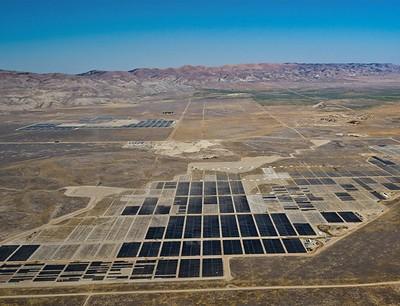First solar projects approved under the Desert Renewable Energy Conservation Plan
WASHINGTON — The Department of the Interior announced today it has approved two solar projects with a third nearing final completion on public lands in Riverside County, Calif., underscoring the Department’s commitment to promoting onshore renewable energy production. The three projects will generate roughly 1,000 megawatts (or 1 gigawatt of power) and are the first projects approved under the Desert Renewable Energy Conservation Plan (DRECP) in the desert regions of seven California counties.
The Bureau of Land Management (BLM) approved the Arica and Victory Pass solar projects, paving the way for construction of photovoltaic solar projects that will generate a total of up to 465 megawatts of electricity with up to 400 megawatts of battery storage. Together, these renewable energy projects will result in an estimated combined infrastructure investment of $689 million, $5.9 million in annual operational economic benefit and power approximately 132,000 homes.
In the coming days, the BLM expects to approve the Oberon solar project, a 500-megawatt photovoltaic solar project on 2,700 acres of public lands that could generate up to 500 megawatts of renewable energy and power nearly 142,000 homes.
“As the Interior Department continues to lead the Biden-Harris administration’s all-of-government approach toward its ambitious renewable energy goals, we know that onshore solar projects like those being advanced today will help communities across the country be part of the climate solution while creating good-paying union jobs,” said Secretary Deb Haaland. “We will continue to work in partnership with states, cities, and Tribes to make historic investments in boosting climate resiliency, advancing clean energy projects, and replacing aging infrastructure.”
“The efficient deployment of renewable energy projects will create good-paying jobs and are crucial in achieving the Biden-Harris administration’s goal of a carbon pollution-free power sector by 2035,” said BLM Director Tracy Stone-Manning. “Investing in clean and reliable renewable energy represents the BLM’s commitment for addressing climate change and supports Congress’ direction in the Energy Act of 2020 to permit 25 gigawatts of solar, wind, and geothermal production on public lands no later than 2025.”
Building infrastructure and creating jobs to advance a clean energy future is a hallmark of the Biden-Harris administration and the historic Bipartisan Infrastructure Law.
The BLM this week also announced it is soliciting interest for utility-scale solar energy development on nearly 90,000 acres of public land located across Colorado, Nevada, and New Mexico. The solicitation is the agency’s largest for solar development interest since it designated 17 solar energy zones in a comprehensive 2012 solar energy planning effort.
The Arica, Victory Pass and Oberon solar projects are within areas identified as suitable for renewable energy development as part of the DRECP, which focuses on 10.8 million acres of public lands in the desert regions of seven California counties. This landscape-level plan streamlines renewable energy development while conserving unique and valuable desert ecosystems and providing outdoor recreation opportunities.
The DRECP is a collaborative effort between the BLM, Fish and Wildlife Service, California Energy Commission and California Department of Fish and Wildlife. To approve these sites for renewable energy projects, the Department and the BLM work with Tribal governments, local communities, state regulators, industry, and other federal agencies.
The BLM is currently processing 54 utility-scale onshore clean energy projects proposed on public lands in the western U.S. This includes 40 solar projects, 4 wind projects, 4 geothermal projects, and 6 interconnect gen-tie lines that are vital to clean energy projects proposed on non-federal land. The 54 projects have the combined potential to add over 27,500 megawatts of renewable energy to the western electric grid. The BLM is also undertaking the preliminary review of 64 applications for solar and wind development, as well as 47 applications for wind and solar energy testing.
 Alternative Energy HQ solar power for homes, wind energy, and bio fuel issues
Alternative Energy HQ solar power for homes, wind energy, and bio fuel issues







